The Radeon R9 280X Review: Feat. Asus & XFX - Meet The Radeon 200 Series
by Ryan Smith on October 8, 2013 12:01 AM ESTOverclocking
With our look at the stock performance of our 280X cards complete, let’s take a brief look at overclocking.
When it comes to overclocking this is going to be a somewhat unfair competition for the two cards. The Asus card has by the very necessity of its existence already been binned. Furthermore while the Asus card supports voltage adjustments the XFX card does not (MSI Afterburner says it does, but adjusting the value has no effect). As such we get to drive what’s already a better GPU harder and with more voltage than the other. Still, this will give us the chance to see where everything will top out at.
| Radeon R9 280X Overclocking | ||||
| XFX Radeon R9 280X DD | Asus Radeon R9 280X DCU II TOP | |||
| Shipping Core Clock | 850MHz | 970MHz | ||
| Shipping Boost Clock | 1000MHz | 1070Mhz | ||
| Shipping Memory Clock | 6GHz | 6.4GHz | ||
| Shipping Boost Voltage | 1.2v | 1.2v | ||
| Overclock Core Clock | 880MHz | 1010MHz | ||
| Overclock Boost Clock | 1030MHz | 1110MHz | ||
| Overclock Memory Clock | 6.6GHz | 6.8GHz | ||
| Overclock Max Boost Voltage | 1.2v | 1.263v | ||
As it turns out, neither card overclocked by very much. The XFX card, lacking additional voltage, could only do 30MHz more, for a 4% base/3% boost overclock. Better luck was found on the memory with a 600MHz (10%) overclock there. The Asus card meanwhile was good for 40MHz more, for a 4% base/4% boost overclock, while its memory could do an additional 800MHz (13%). But at the same time this required dialing the voltage up to 1.263v – as high as we’re willing to go for this card. The power cost of doing that will be extreme.
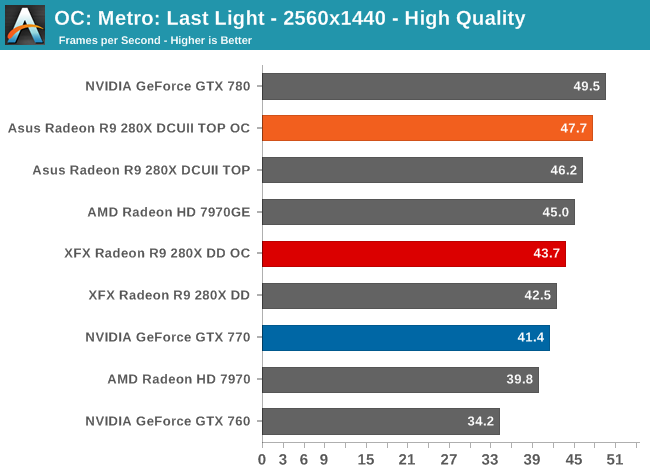
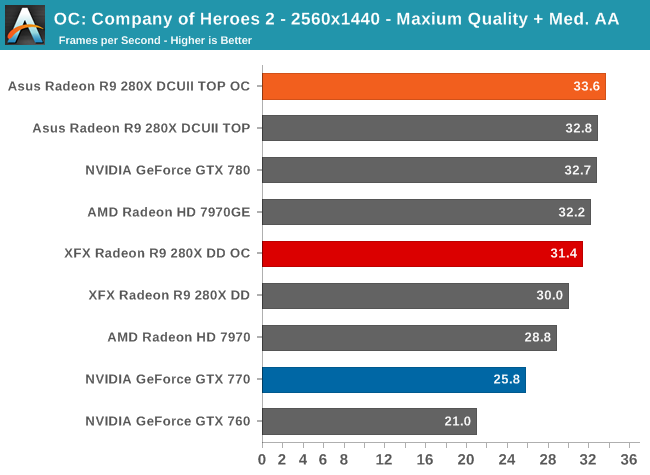
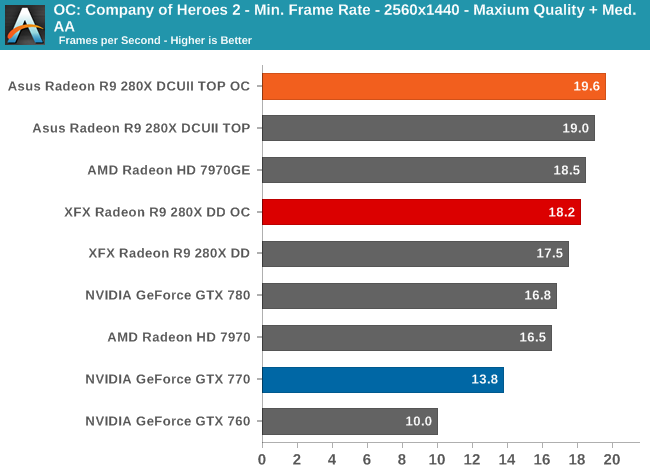
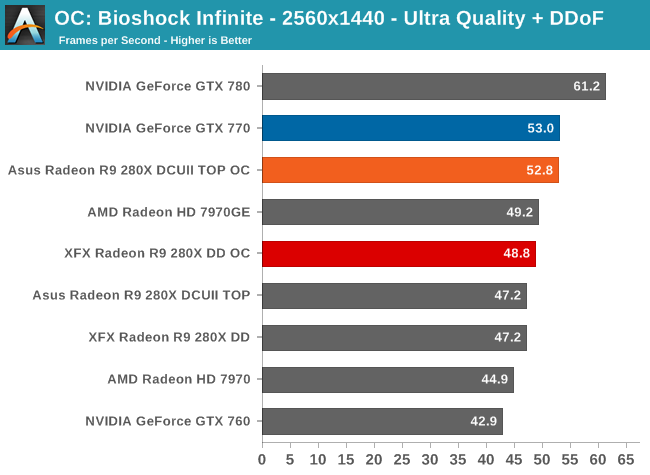
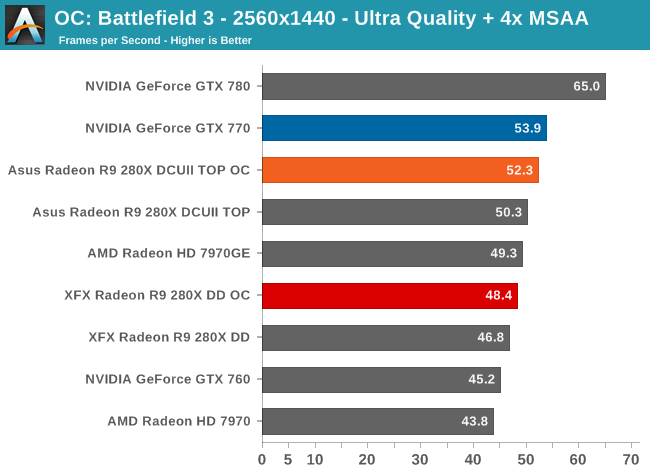
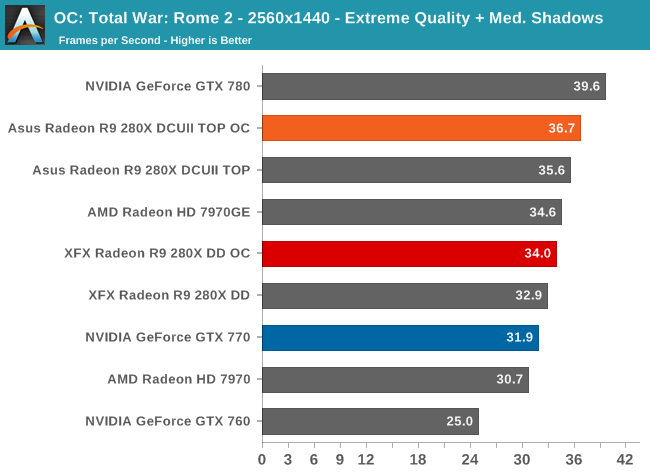
With our 280X cards primarily bottlenecked by GPU performance as opposed to memory performance, the performance gains from our overclocking adventure is limited. 3% on average for both cards is 3% for free, but it’s barely a useful overclock. We typically need 5% before overclocks start becoming interesting and significant enough to improve playability or make higher graphical settings practical.
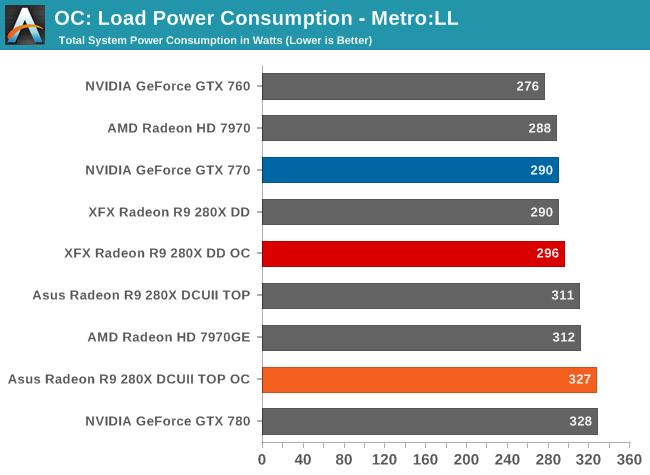
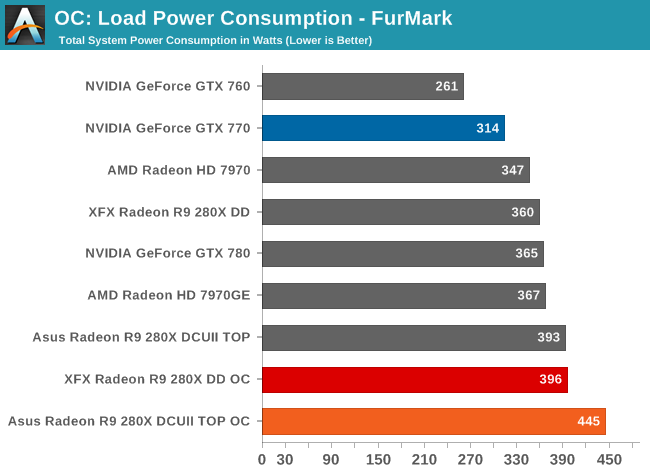
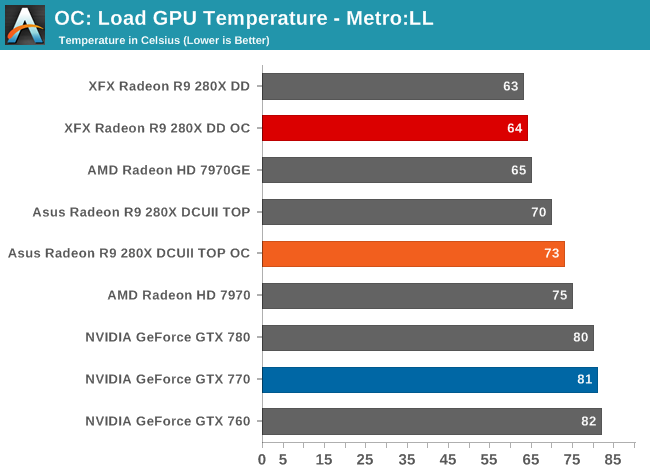
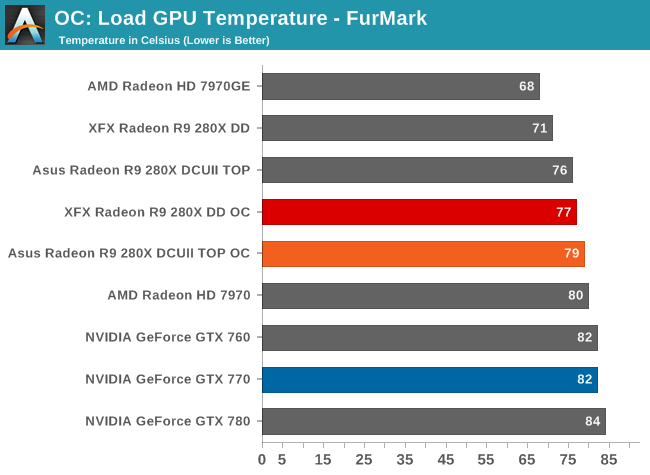
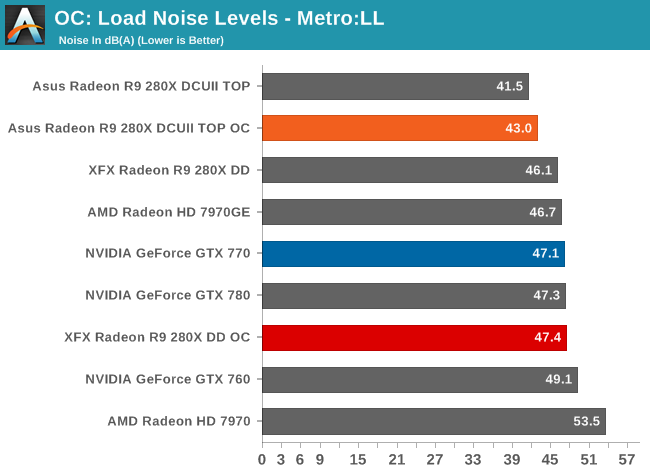
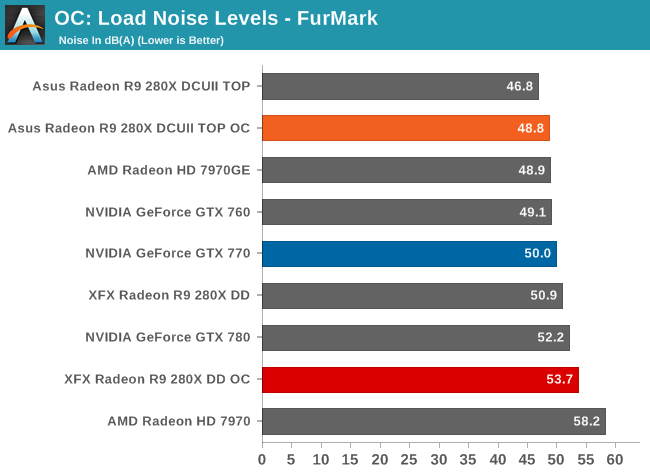
To the credit of the Asus card and its cooler, despite the increased clockspeeds, voltage, and power consumption, it’s able to keep GPU temperatures and load noise to reasonable levels given the circumstances. Still, with the increase in power required to achieve this overclock (particularly in the worst case scenario of FurMark) it’s hard to argue that the additional overclocking was worth the performance gains. With such an extensive factory overclock this is a card that may be better off left at factory clocks.
The XFX card meanwhile suffers much less of a power ramp up due to the lack of voltage control, but we’re still looking at something of a wash on the power/performance front.










151 Comments
View All Comments
nathanddrews - Tuesday, October 8, 2013 - link
GTX700 = GTX770, derp.Da W - Tuesday, October 8, 2013 - link
Sure. Just go to your job every day and work hard just to give free stuff at people.nathanddrews - Tuesday, October 8, 2013 - link
Who said anything about giving "free stuff at people"? I'm talking about competitive pricing - the NVIDIA lineup is overpriced.Mondozai - Tuesday, October 8, 2013 - link
Speaking of which, we could use an edit function ;)Mondozai - Tuesday, October 8, 2013 - link
Nah, they are more logical now. People are just bitching because their head hurts when re-adjusting.JPForums - Tuesday, October 8, 2013 - link
So, the 280X is a 7970(not quite)GHz edition that is not quite price competitive with overclocked 7970s that give you essentially the same thing.The 270X is a 7870 with a token boost clock and better memory bandwidth. Unfortunately it is priced $20 ($50 w/MIR) more expensive than the generally more powerful 7870XT.
The 260XT is a 7790 with a somewhat meaningful boost clock. Too bad it is priced closer to a 7850 than a 7790. Mail-in-Rebates only make the situation worse.
Well, ... , I'm underwhelmed.
7970 (OC) - $300 ($280 w/MIR)
http://www.newegg.com/Product/Product.aspx?Item=N8...
7870XT - $180 ($150 w/MIR)
http://www.newegg.com/Product/Product.aspx?Item=N8...
7850 - $145 ($125 w/MIR)
http://www.newegg.com/Product/Product.aspx?Item=N8...
7790 - $120 ($100 w/MIR)
http://www.newegg.com/Product/Product.aspx?Item=N8...
JPForums - Tuesday, October 8, 2013 - link
Note: The AMD news section seems to be penta-posting articles. Please remove this comment once corrected.noeldillabough - Tuesday, October 8, 2013 - link
I loved the 290x specs chart :0alfredska - Tuesday, October 8, 2013 - link
Ryan, you need a better editor -- or an editor, period. Here's the first four paragraphs of your "Final Words", cleaned up and less abrasive:Bringing this review to a close, the initial launch of the Radeon 200 series is something of a warm-up act. AMD’s Big Kahuna, the R9 290X, is not yet here and will be a story of its own. In the meantime, AMD has kicked off 2014 with the bulk of their graphics lineup.
As far as performance is concerned, the 200 series is more of a refresh of the existing Tahiti, Pitcairn, and Bonaire GPUs than a revolution. The performance is is only a few percent better on average. While I wouldn't call this a new coat of paint on the 7000 series, these products are still largely unchanged from those we’ve seen over the last two years.
Today’s launch represents a consolidation of products and a formalization of prices. The number of products based on the each GPUs has been cut down significantly; there’s now only 1 card per GPU as opposed to 2 or 3. AMD can lower the prices on existing products, redefining the high-end, enthusiast, and mainstream markets, as opposed to flogging cards based on the 7970 as sub-$300 enthusiast parts. Nearly two years in, these parts are hitting what should have been their introductory prices.
Today, there’s no getting around the fact that similar 7000 series products are going to be equal in price or cheaper than 200 series products. Once this supply dries up, however, the 200 series will settle into a more typical product stratification. Then, we'll see AMD’s partners react to competitive pressure and adjust prices and bundles accordingly. We expect to see the return of the Never Settle Forever program for these cards.
Razorbak86 - Tuesday, October 8, 2013 - link
"Is is" that so? "The each GPUs" reveals your true editorial prowess.Pro-tip: Don't quit your day job. ;)